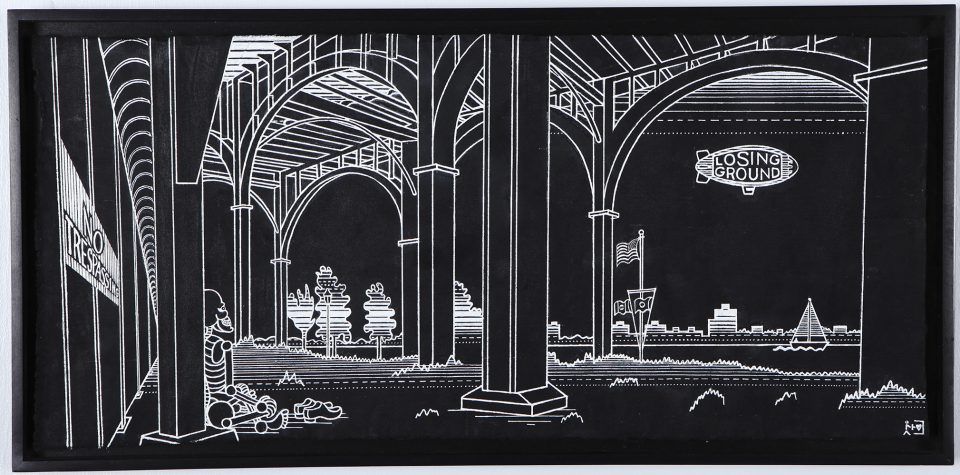


At first glance, Anthony Dominguez’s work in Exit/Alive appears to be dark and steeped with foreboding images of death and misery. Infused with Native American, Mexican, and tribal styles, Dominguez’s work at a closer glance tells much more of story than death. Many of the living figures in his work are accompanied by death, as represented by the skull figures, and they begin to tell a romantic tale of the interaction of both life and death. A push and pull, the yin and yang; there can be no life without death, and no death without life. This understanding of the work is a direct reflection of Dominguez’s view of life itself. He understood that living in fear of death would never allow one to never fully realize oneself to actuality. This is specifically reflected in the piece Master & Slave; the living figure appears to be giving part of himself to his heart and also allowing death to embrace him simultaneously.
It is a very common battle many have; do you follow your heart and dreams, or do you follow the drone of society? Dominguez shows in this piece that to follow one’s heart, one must embrace the potential of death. Death here could mean many things like financial disparity and stability, suffering the disappointment of those around you, living a life that goes against the grain, or death itself. Dominguez understood these drawbacks, and yet he embraced them. He knew that by doing this he would be forever transformed for the better, as seen in the butterfly flying from death’s hand.
This is the beauty of Dominguez’s work, there is a very deep level of interpretation that makes looking at his work so intimate. Viewers are forced to see in each piece the concept death itself, and they must reflect upon their own views of the subject. Suddenly, the idea of dying and what comes after it is staring at one in the face (often with a grin). The deep philosophical nature of Dominguez’s work is mainly brought about by his days spent in solitude in the streets of New York.
In his later works we begin to see his opinion of the outside world, rather than his internal mindset. Images of police, broken chains, a crying Statue of Liberty, apples, and hands are scattered throughout. Some of these pieces include a new color addition: red. The introduction to this color is interesting. Why red? Red is associated with many emotions; such as love, anger, or strength. Red, as a color, is very assertive and confident in these pieces. It does make one wonder if the choice of red stemmed from an increasingly confident Dominguez, ready to speak out about the problems he saw in society.
Dominguez’s work is a shining example of how the voices of the marginalized in society should not be ignored or hushed. Their message is often profound and raw. It does make one wonder what other voices are just as beautiful as Dominguez are out there, ignored and passed by on the street. Dominguez represents more than an artist with an opinion, he represents the ignored voices finally being able to scream to the world what they think.
By Jon David Rochelle, Halsey Institute Intern